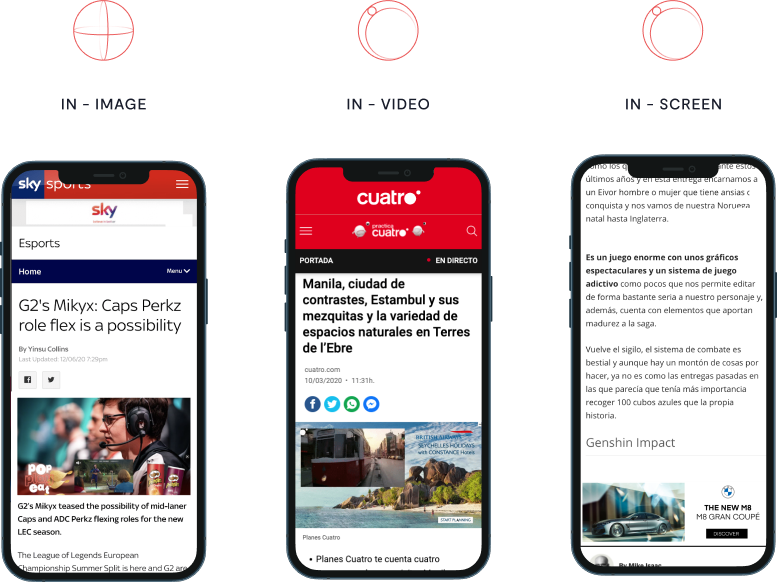Jun'21·Andrés Auchterlonie·5 MIN
In for a cookie, out in a jiffy – Why contextual targeting is better
Third Party Cookies·
Interested in discovering more about how our contextual advertising can help elevate your brand?
For AdvertisersFor PublishersGet the latest news about contextual advertising straight into your inbox!
Ever since privacy regulations like GDPR and CCPA came into force and Google announced it would remove third-party cookies from Chrome in 2023, the world is abuzz with debates on the fate of online advertisements.
With cookie culture fast becoming yesterday’s news, contextual advertising is conveniently filling up the void. It goes beyond traditional advertising and brings an unprecedented brilliance to the tables of modern advertisers.
What makes contextual ads a better bet in today’s privacy-first world?
We live in a privacy-first world, where consumers want better control and transparency over how their data is being used. With contextual ads, privacy concerns are no longer an issue! Since contextual targeting is based on the content and context of a particular website or article where the ad is placed, rather than the user’s personal data, it is naturally in tune with the changing data protection standards
“Contextual advertising ensures advertisements are delivered into the in-content placements that best capture user attention, without the use of cookies or collecting Personally Identifiable Information (PII).”

Contextual ads allow brands to capitalise on various forms of content like visual, videos, or text-only web pages that fit their contextual strategy, whilst respecting the user’s privacy. This is what makes contextual targeting a better choice in today’s world.
A way to stay brand safe
As advertisers are increasingly becoming cautious about where their ads are displayed, brand safety and brand suitability have taken center stage. Unfortunately, the traditional keyword blocking and URL blocklist methods are ineffective and unreliable.
For example, let’s take the word ‘war’. A traditional keyword blocking method would straightaway block this word associating it with violence and negativity. But, there are words such as ‘COVID warriors’ which contain the word ‘war’, that give a very different meaning. It’s not only a gross misunderstanding of brand safety but also a missed opportunity.
Instead of blindly blocking keywords or URLs, contextual advertisements are designed to analyze web pages, audios, and videos, with human-like intelligence. Thus, they are rightfully also called True contextual intelligence solutions.
“On the other hand, brand suitability bridges the divide between risk and opportunity through rigorous, context-based protections for advertisers. But, the crucial element here is ‘context,’ without which no adequate brand safety and suitability strategy can occur.”
What’s in it for advertisers?
Contextual targeting facilitates advertisers to reach out to their target audiences more effectively based on content and context. Through human-like analysis of content and better sentiment analysis, advertisers can now improve keyword selection and ad placements to enhance relevance, context, personalization, and brand recall.
How are publishers benefiting from contextual advertising?
To run ad campaigns effectively, publishers must collect user data from operating systems, websites visited, CTAs, etc. This is where regulations like GDPR become a hurdle because publishers need to ask users for permissions.It goes without saying that User Experience (UX) plays a pivotal role in grabbing visitor’s attention.
“Contextual ads offer publishers a great leeway in providing better user experience by allowing them to place ads that are non-intrusive and seamlessly in sync with the information around it.”
Relevance is another advantage. By placing relevant ads, publishers are in a more favorable position as it entices people to take action, thus leading to better click-through rate, and eventually increase in revenue.
In a privacy-first world, the combination of contextual AI and in-content ad placements help publishers boost revenues as well. It is the best way for publishers to monetize their content in full, as the solutions are user friendly, non-intrusive, and ensure better UX.
Contextual ads allow publishers to avail other benefits as well, such as:
- No privacy violations
- Easier to manage brand reputation
- Convenient and economical in execution
- More relevant than behavioral advertising

Contextual targeting in 2021 and beyond
Given the flexible and fluid nature of contextual advertising, advertisers and publishers are pushing the boundaries and inventively experimenting with it.
“With more advanced technologies being fused into it and implementing them in innovative ways, contextual ads are moving ahead of their time – and the results are extraordinary.
AI, ML, and NLP
Today, contextual has opened doors for advertisers to move beyond keywords and explore AI and ML to find the most relevant content. Natural Language Processing (NLP) can help in the deep understanding of the context and sentiment of web pages.
Image analysis
Machine learning can also analyze videos, audio clips, and images to better understand their meaning.
Real-time Feedback
Contrary to traditional ad feedback, contextual ads, augmented with AI, can be programmed to continuously verify ads on relevant domains. This feedback loop enables publishers and advertisers to revise their ad copies in real-time to improve the success of their campaigns.
Third Party Cookies·
Share this articleJun'22·Jordi Capdevila·3 MIN
Seedtag acquires KMTX in a strategic step to power contextual performance for advertisers
See nextContextual Targeting



